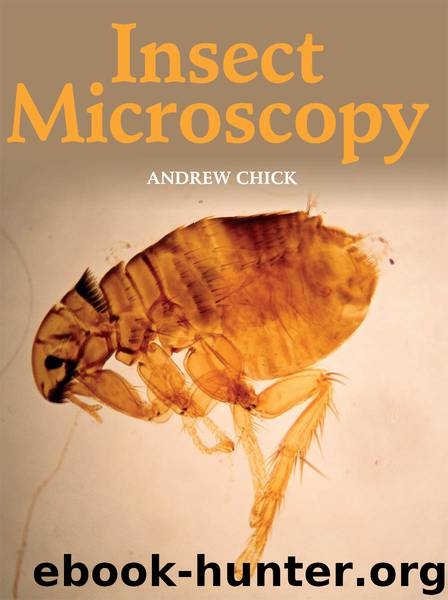Insect Microscopy by Andrew Chick

Author:Andrew Chick
Language: eng
Format: epub
Publisher: The Crowood Press
CHAPTER SIX
DISSECTION
Dissection of insect specimens can serve an important function in the study of entomology; some groups are dissected and slide mounted as a standard form of preservation, others are part dissected to example parts of the anatomy that are crucial for critical identification.
One might also dissect a specimen to better understand its feeding habits or ecology, others may dissect as a way of learning hands-on how an insect functions. I keenly remember during my PhD studies dissecting hundreds of blowfly pupae to investigate how nicotine affected the development of the adults. Each pupae was dissected from its pupal casing and photographed meticulously, and as each pupal casing was peeled back I was granted a glimpse through a window to how these insects develop.
Dissection is a catch-all term for cutting up specimens with a scientific aim and as such there are a number of forms of dissection used within entomology. Here dissection shall be divided into genitalia dissection, gut content analysis, anatomical dissection, dissection for identification and histological sectioning.
When dissecting a specimen it is imperative that you use fresh specimens, as the soft tissues easily rot even after they have been preserved.
Genitalia dissection
Since for some species reliable identification requires looking at the structure of the genitalia, this is the most common form of entomological dissection. The process of dissection and the standard form of preserving the dissected genitalia varies with each group; however a basic overview is to be provided here with links to further information.
Dry specimens
When dissecting dry specimens relaxing of the specimen is required. There are a number of ways to relax a specimen, including a range of commercially available ‘relaxing fluids’ such as barber’s fluid. I have had success with barber’s fluid applied directly to the abdomen.
I have also had success using the vinegar jar recommended by Telfer (2015) in which a small amount of an absorbent material is damped with pickling vinegar and added to a jar; the specimens are added on top of the absorbent material. Others recommend a similar method using water in place of the vinegar, but these tend to encourage mould unless some antifungal agent is added. I use a vinegar relaxing jar for most specimens and barber’s fluid for specimens with lots of bristles or scales, which tend to get damaged by the humid vinegar jar.
Dissection procedure
Dissection is best carried out under a stereo microscope. The type of dissection dish used will largely depend upon personal preference and the type of specimen being dissected. My personal preference around 75 per cent of the time is to use a biologist spotting pallet or an excavated glass block. The genitalia are very delicate and great care must be taken during the dissection.
Depending on the type of specimen to be dissected its treatment varies. For example, the Lepidoptera Dissection Group (2015) recommend removing the whole abdomen. Erzinçlioglu (1996) also advocates removal of the abdomen in blowflies to access the genitalia. However Raper (2015) states that the genitalia can be teased out of Diptera such as blowflies without removing the abdomen.
Download
This site does not store any files on its server. We only index and link to content provided by other sites. Please contact the content providers to delete copyright contents if any and email us, we'll remove relevant links or contents immediately.
Hands-On Genetic Algorithms with Python by Eyal Wirsansky (2020) by Unknown(4052)
Thing Explainer by Randall Munroe(3875)
The Elements by Theodore Gray(2995)
The Meaning of it All by Richard Feynman(2298)
Make by Mike Westerfield(2287)
Every Tool's a Hammer by Adam Savage(1887)
Science Experiments You Can Eat by Vicki Cobb(1838)
The Perfectionists by Sara Shepard(1781)
Martin Gardner's Science Magic by Martin Gardner(1685)
Raspberry Pi Electronics Projects for the Evil Genius (Tab) by Norris Donald & Norris Donald(1673)
Elephants on Acid by Boese Alex(1565)
Elephants on Acid: And Other Bizarre Experiments by Alex Boese(1563)
The Perfectionists by Simon Winchester(1555)
Handbook of Modern Sensors by Jacob Fraden(1542)
Synchrotron Light Sources and Free-Electron Lasers by Eberhard J. Jaeschke Shaukat Khan Jochen R. Schneider & Jerome B. Hastings(1523)
Tesla by Carlson W. Bernard(1484)
The Science of Food by Marty Jopson(1447)
The Meaning Of It All by Richard P. Feynman(1420)
125 Physics Projects for the Evil Genius by Silver Jerry(1416)
